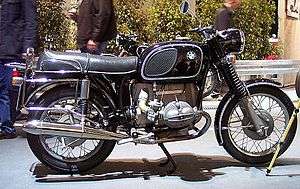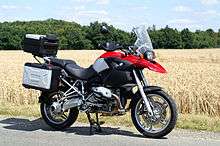History of BMW motorcycles
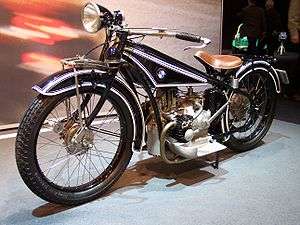
BMW's motorcycle history began in 1921 when the company commenced manufacturing engines for other companies. Motorcycle manufacturing now operates under the BMW Motorrad brand. BMW (Bayerische Motoren Werke AG) introduced the first motorcycle under its name, the R32, in 1923 to 1925.
Motorcycle history
_-_The_Art_of_the_Motorcycle_-_Memphis.jpg)
Pre-1921
BMW began in 1916 as a reorganization of Rapp Motorenwerke, an aircraft engine manufacturer that began production before World War I. With the Armistice, the Treaty of Versailles banned the German air force and the manufacture of aircraft in Germany, so the company turned to making air brakes, industrial engines, agricultural machinery, toolboxes and office furniture and then to motorcycles and cars.
1921–1945
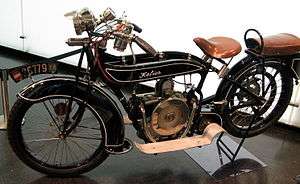
In 1921, BMW began manufacture of its M2B15 flat-twin engine. Designed by Max Friz for use as a portable industrial engine, the M2B15 was largely used by motorcycle manufacturers, notably Victoria of Nuremberg, and Bayerische Flugzeugwerke in their Helios motorcycle.[1][2] Friz was also working on car engines.
BMW merged with Bayerische Flugzeugwerke in 1922, inheriting from them the Helios motorcycle and a small two-stroke motorized bicycle called the Flink.[1][2] In 1923, BMW's first "across the frame" version of the boxer engine was designed by Friz. The R32 had a 486 cc (29.7 cubic inches) engine with 8.5 hp (6.3 kW) and a top speed of 95 to 100 km/h (59 to 62 mph).[3] The engine and gearbox formed a bolt-up single unit. At a time when many motorcycle manufacturers used total-loss oiling systems, the new BMW engine featured a recirculating wet sump oiling system with a drip feed to roller bearings. This system was used by BMW until 1969, when they adopted the "high-pressure oil" system based on shell bearings and tight clearances, still in use today.
The R32 became the foundation for all future boxer-powered BMW motorcycles. BMW oriented the boxer engine with the cylinder heads projecting out on each side for cooling as did the earlier British ABC. Other motorcycle manufacturers, including Douglas and Harley-Davidson, aligned the cylinders with the frame, one cylinder facing towards the front wheel and the other towards the back wheel. The R32 also incorporated shaft drive. BMW has continued to use shaft drive on its motorcycles and did not produce a chain driven model until the introduction of the F650 in 1994.
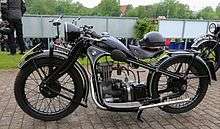
In 1925, BMW introduced the R39, a 250 cc single-cylinder motorcycle. It was not successful and was discontinued in 1927.[4] In 1931, BMW introduced the single-cylinder shaft-driven R2,[5] which, as a 200 cc motorcycle, could be operated in Germany without a motorcycle licence at that time.[6][7] The R2 headed a series of single-cylinder BMW motorcycles, including the 400 cc R4 in 1932 and the 300 cc R3 in 1936.[8]
.jpg)
The BMW R12 and R17, both introduced in 1935, were the first production motorcycles with hydraulically damped telescopic forks.[5][9]
In 1937, Ernst Henne rode a supercharged 500 cc (31 cubic inches) overhead camshaft BMW 173.88 mph (279.83 km/h), setting a world record that stood for 14 years.

During World War II the Wehrmacht needed as many vehicles as it could get of all types and many other German companies were asked to build motorcycles. The R75 performed particularly well in the harsh operating environment of the North African Campaign. Motorcycles of every style had performed acceptably well in Europe but, in the desert, the protruding cylinders of the flat-twin engine performed better than other configurations which overheated in the sun. Shaft drives also performed better than chain-drives which were damaged by desert grit.
The U.S. Army took note of these advantages and asked Harley-Davidson, Indian and Delco to produce a motorcycle similar to the side-valve BMW R71. Harley-Davidson copied the BMW engine and transmission—simply converting metric measurements to inches—and produced the shaft-drive 750 cc (46 cubic inches) 1942 Harley-Davidson XA.[10]
1945–1955



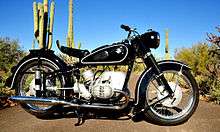
The end of World War II found BMW in ruins. Its plant outside of Munich was destroyed by Allied bombing. The Eisenach facility, while badly damaged, was not totally destroyed, and tooling and machinery had been stored safely nearby. Contrary to popular accounts, the facility was not dismantled by the Soviets as reparations and sent to the Soviet Union to be reassembled in Irbit to make IMZ-Ural motorcycles; the IMZ plant was supplied to the Soviets by BMW under license before the German invasion of the Soviet Union in June 1941. After the war, most of BMW's engineers were taken to the US or the Soviet Union to continue the work they had done on jet engines with BMW during the war.
The terms of Germany's surrender forbade BMW from manufacturing motorcycles. In 1947, when BMW received permission to restart motorcycle production from US authorities in Bavaria,[11] BMW had to start from scratch. There were no plans, blueprints, or schematic drawings because they were all in Eisenach. Company engineers had to use surviving pre-war motorcycles to copy the bikes. The first post-war BMW motorcycle in Western Germany, a 250 cc R24, was produced in 1948. The R24 was reverse-engineered from the pre-war R23 with some improvements over the R23,[12] and was the only postwar West German BMW without rear suspension. In 1949, BMW produced 9,200 units and by 1950 production surpassed 17,000 units.
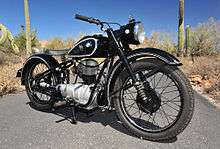

BMW boxer twins manufactured from 1950 to 1956 included the 500 cc models R51/2 and 24 hp (18 kW) R51/3, the 600 cc models 26 hp (19 kW) R67, 28 hp (21 kW) R67/2, and R67/3, and the sporting 35 hp (26 kW) 600 cc model R68. All these models came with plunger rear suspensions, telescopic front forks, and chromed, exposed drive shafts. Except for the R68, all these twins came with "bell-bottom" front fenders and front stands.
The situation was very different in Soviet-controlled Eastern Germany where BMW's sole motorcycle plant in Eisenach was producing R35 and a handful of R75 motorcycles for reparations. This resulted in one BMW motorcycle plant existing in Eisenach between 1945 and 1948 and two motorcycle companies existing between 1948 and 1952. One was a BMW in Munich in Western Germany (later the German Federal Republic) and the other in Soviet controlled Eisenach, Eastern Germany (later the German Democratic Republic), both using the BMW name. Eventually in 1952. after the Soviets ceded control of the plant to the East German Government, and following a trademark lawsuit, this plant was renamed EMW (Eisenacher Motoren Werke). Instead of BMW's blue-and-white roundel, EMW used a very similar red-and-white roundel as its logo.[13] No motorcycles made in East Germany after World War II were manufactured under the authority of BMW in Munich as there was no need for an occupying power to gain such authority. BMW R35 motorcycles were produced in Eisenach until 1952, when they became EMW.
1955–1969

As the 1950s progressed, motorcycle sales plummeted. In 1957, three of BMW's major German competitors went out of business. In 1954, BMW produced 30,000 motorcycles. By 1957, that number was less than 5,500.

In 1955, BMW began introducing a new range of motorcycles with Earles forks and enclosed drive shafts. These were the 26 hp (19 kW) 500 cc R50, the 30 hp (22 kW) 600 cc R60, and the 35 hp (26 kW) sporting 600 cc R69.
On June 8, 1959, John Penton rode a BMW R69 from New York to Los Angeles in 53 hours and 11 minutes, slashing over 24 hours from the previous record of 77 hours and 53 minutes set by Earl Robinson on a 45 cubic inch (740 cc) Harley-Davidson.
Although U.S. sales of BMW motorcycles were strong, BMW was in financial trouble. Through the combination of selling off its aircraft engine division and obtaining financing with the help of Herbert Quandt, BMW was able to survive. The turnaround was thanks in part to the increasing success of BMW's automotive division. Since the beginnings of its motorcycle manufacturing, BMW periodically introduced single-cylinder models. In 1967, BMW offered the last of these, the R27. Most of BMW's offerings were still designed to be used with sidecars. By this time sidecars were no longer a consideration of most riders; people were interested in sportier motorcycles.
The 26 hp (19 kW) R50/2, 30 hp (22 kW) R60/2, and 42 hp (31 kW) R69S marked the end of sidecar-capable BMWs. Of this era, the R69S remains the most desirable example of the dubbed "/2" ("slash-two") series because of significantly greater engine power than other models, among other features unique to this design.[14]
For the 1968 and 1969 model years only, BMW exported into the United States three "US" models. These were the R50US, the R60US, and the R69US. On these motorcycles, there were no sidecar lugs attached to the frame and the front forks were telescopic forks, which were later used worldwide on the slash-5 series of 1970 through 1973. Earles-fork models were sold simultaneously in the United States as buyers had their choice of front suspensions.
1970–1982
In 1970, BMW introduced an entirely revamped product line of 500 cc, 600 cc and 750 cc displacement models, the R50/5, R60/5 and R75/5 respectively,[15][16] which came with the "US" telescopic forks noted above. The engines were a complete redesign. The roller and ball-bearings in the bottom end had been replaced by shell-type journal bearings similar to those used in modern car engines.[15][16] The camshaft, which had been at the top of the engine, was placed under the crankshaft,[15] giving better ground clearance under the cylinders while retaining the low centre of gravity of the flat-twin layout. The new engine had an electric starter, although the traditional gearbox-mounted kick starter was retained.[15] The styling of the first models included chrome-plated side panels and a restyled tank. The /5 series was given a longer rear swingarm, resulting in a longer wheelbase. This improved the handling and allowed a larger battery to be installed.
The /5 models were the first to be built at BMW's new motorcycle factory in Spandau, West Berlin.[15][17] Motorcycle production had been relocated from the Milbertshofen factory in Munich to this factory, which had been built on the site earlier occupied by a Siemens aircraft engine factory.[18][19]
The /5 models were short-lived, however, being replaced by another new product line in 1974. In that year the 500 cc model was deleted from the lineup and an even bigger 900 cc model was introduced, as was a five-speed gearbox,[16][20] and improvements to the electrical system and frame geometry. These models were the R60/6, R75/6 and the R90/6. In 1973 a supersport model, the BMW R90S, was introduced.[16][20] In 1975, the kick starter was finally eliminated.[20]

In 1977, the product line moved on to the "/7" models. The R80/7 was added to the line. The R90 (898 cc) models, "/6" and R90S models were replaced by updated versions with a new 1,000 cc; engine, the R100/7, the R100S and the new super sport model the R100RS with a full fairing. This sleek model, designed through wind-tunnel testing, produced 70 hp (51 kW) and had a top speed of 200 km/h (124 mph).[21] The R100RS had a shorter rear end ratio to overcome the higher wind resistance of the full fairing. Many period motorcycle tests in Germany (Das Motorrad) indicated it was actually slightly slower than the R100S with only 65 hp. In 1978, the R100RT was introduced into the lineup for the 1979 model year, as BMW's first "full-dress" tourer. The RS and RT fairings were very similar in appearance; however, the RS fairing was essentially a lightweight streamlining/protective shell and windscreen with no other functions, while the RT shell was heavier and had two "glove box" lockable compartments, ventilation louvres and an adjustable windscreen. The RT fairing was widely used for police motorcycles, with radio equipment in the fairing compartments.
In 1979, the R60 was replaced with the 650 cc R65, an entry-level motorcycle with 48 hp (36 kW) that had its very own frame design. Due to its smaller size and better geometrics, front and rear 18-inch (460 mm) wheels and a very light flywheel, was an incredibly well-handling bike that could easily keep up and even run away from its larger brothers when in proper hands on sinuous roads. BMW added a variant in 1982: the R65LS, a "sportier" model with a one-fourth fairing, double front disc brakes, stiffer suspension and different carburettors that added 5 hp (4 kW).
1983–2003


In early 1983, BMW introduced a 987 cc, in-line four-cylinder, water-cooled fuel injected engine to the European market, the K100. The K series comes with a simplified and distinctive rear suspension, a single-sided swingarm. (In 1985 the traditionally powered boxer R80RT touring bike received this monolever rear suspension system and in 1987 the R100RT received it).
In 1985, BMW introduced a 750 cc three-cylinder version, this one smoothed with another first, a counterbalance shaft.
In 1986, BMW introduced an electrically adjustable windshield on the K100LT.
In 1988, BMW introduced ABS on its motorcycles. ABS became standard on all BMW K models. In 1993 ABS was first introduced on BMW's boxer line on the R1100RS. It has since become available as an option on the rest of BMW's motorcycle range.
In 1989, BMW introduced its version of a full-fairing sport bike, the K1. It was based upon the K100 engine, but now with four valves per cylinder. Output was near 100 hp (75 kW).
In 1995, BMW ceased production of airhead 2-valve engines and moved its boxer-engined line completely over to the 4-valve oilhead system first introduced in 1993.
During this period, BMW introduced a number of motorcycles including:
- R Series (airheads) - R65GS, R80GS, R100GS, and the R100gspd, which was marketed to celebrate the winning of the famous Paris to Dakar cross country race by a modified GS airhead BMW. This model is highly coveted by BMW collectors and long distance 'around the world' travelers because of its reliability and ease of maintenance and repair.
- R Series (oilheads) - R850R/GS/C, R1100S/RS/RT/R/GS/S, R1150R/RS/RT/GS/S, R1200C
- F Series - F650 Funduro, F650ST Strada, F650GS, F650GS Dakar, F650CS Scarver
- K Series - K1, K100, K100RS, K100RT, K75, K75C, K75S, K75RT, K1100RS, K1100LT, K1200RS, K1200LT, K1200GT.
- C1 enclosed scooter
The R1200C, produced from 1997 to 2004, was BMW Motorcycle's only entry into the Cruiser market. At the other end of the model lineup, the C1, produced from 2000 to 2002, was an enclosed scooter, the only scooter to be offered for sale by BMW.
Since 2004
K series
On 25 September 2004, BMW globally launched a radically redesigned K Series motorcycle, the K1200S, containing an all new in-line four-cylinder, liquid-cooled engine featuring 123 kW (165 hp).[22] The K1200S was primarily designed as a Super Sport motorcycle, albeit larger and heavier than the closest Japanese competitors. Shortly after the launch of the K1200S, problems were discovered with the new power plant leading to a recall until the beginning of 2005, when corrective changes were put in place.
In the years after the launch of K1200S, BMW has also launched the K1200R naked roadster, and the K1200GT sport tourer, which started to appear in dealer showrooms in spring (March–June) 2006. All three new K-series motorcycles are based on the new in-line four-cylinder engine, with slightly varying degrees of power. In 2007, BMW added the K1200R Sport,[23] a semi-faired sport touring version of the K1200R.
In October 2008, BMW launched three new 1,300 cc K-series models: the K1300R, K1300S and K1300GT.[24] The K1300 models feature an increase in engine capacity of 136 cc, an increase in power to 175 hp (130 kW), newly styled fairings and a new exhaust system.
In 2011, BMW launched two six-cylinder, 1,600 cc, K1600GT and K1600GTL motorcycles, the former intended as a sport-tourer and the latter as a luxury touring model. The engine produces 160 hp (120 kW) and 129 lb·ft (175 N·m). They also offer adaptive headlights, traction control, ABS, tire pressure monitors, and a variety of sound systems.
R series

In 2005, bikes with the opposed-twin-cylinder "boxer" engine were also revamped. The new boxer displacement is 1,170 cc (71 cubic inches). The engine is more powerful, and all of the motorcycles that use it are lighter than their predecessors.
The first motorcycle to be launched with this updated engine was the R1200GS dual-purpose motorcycle. The R1200RT tourer and R1200ST sports tourer followed shortly behind. BMW then introduced the 175 kg (386 lb), 78 kW (105 hp) HP2 Enduro, and the 223 kg (492 lb), 100 hp (75 kW) R1200GS Adventure, each specifically targeting the off-road and adventure-touring motorcycle segment, respectively. In 2007, the HP2 Enduro was joined by the road-biased HP2 Megamoto fitted with smaller alloy wheels and street tyres.
In 2006, BMW launched the R1200R and the R1200S, which is rated at 81 kW (109 hp) @ 7,500 rpm.
In 2014, BMW introduced a completely new R1200RT with 125 hp (92 kW) at 7,750 rpm, 92 lb/ft (125 Nm) torque at 6,500 rpm, and a wet clutch.
In 2015 BMW introduced in the R1200RT keyless ignition and the "San Marino blue" color.
F series

BMW has also paid attention to the F Series in 2006. It lowered the price on the existing F650GS and F650GS Dakar, and eliminated the F650CS Scarver to make room in the lineup for the all-new F800 Series. The new motorcycles are powered by a parallel twin engine, built by Rotax. They feature either a belt drive system, similar to the belt drive found on the now defunct F650CS, or chain drive. Initially, BMW launched two models of the new F800 Series, the F800S sport bike and the F800ST sport tourer; these were followed by F650GS and F800GS dual-purpose motorcycles, both of which use the 798 cc engine despite the different names.[25]
G series

In October 2006, following a nomenclature change, BMW announced the G series of offroad style motorcycles co-developed with Aprilia. These were equipped with an uprated single-cylinder water-cooled 652 cc fuel-injected engine producing 53 hp (40 kW), similar to the one fitted to the single-cylinder F650GS, and equipped with chain drive. Initially, there were three models in the series, all produced for BMW by Aprilia in their North Italian Scorzè Plant, each focused on a slightly different market:
- G650 Xchallenge hard enduro featuring 21 inch front and 18 inch rear spoked wheels[26]
- G650 Xcountry scrambler / adventure sports featuring 19 inch front and 17 inch rear spoked wheels[26]
- G650 Xmoto street moto / supermoto featuring 17 inch cast alloy wheels.[26]
The G450X, a hard-enduro was introduced in 2007,[27] and discontinued in 2010.
At the end of 2010 BMW introduced the G650GS, an extensively facelifted and reworked version of the original F650GS.
HP2 Series
First was the 175 kg (386 lb), 105 hp (78 kW) HP2 Enduro, followed by the road-biased HP2 Megamoto fitted with smaller alloy wheels and street tyres in 2007.
In April 2007, BMW announced its return to competitive road racing, entering a factory team with a "Sport Boxer" version of the R1200S to four 24-hour endurance races.[28] In 2008 they released this as the HP2 Sport.
S1000RR
The S1000RR is a sport bike launched to compete in the 2009 Superbike World Championship.[29] It is powered by a 999 cc (61 cu in) inline-four engine producing 193 bhp (144 kW).
Husqvarna acquisition
In 2007, BMW acquired Husqvarna Motorcycles, including its production facilities and staff, from Italian manufacturer MV Agusta.[30][31] On 31 January 2013, BMW announced that Pierer Industrie AG has bought Husqvarna for an undisclosed amount, which will not be revealed by either party in the future.[32]
Engine types
There are currently four lines of BMW motorcycles:
- F & G series singles
- F series twins
- R series
- K series
The series differ primarily in the class of engine that each uses.
F and G series singles
The F Series of single-cylinder BMW motorcycles was first launched in 1994, as the F650, and was built by Aprilia around a carbureted 650 cc four-stroke, four-valve, single piston engine, and chain drive. The mission for the F 650 was to provide an entry level BMW motorcycle. In 2000, the F650 was redesigned, now with fuel injection, and labeled the F650GS. An off-road focused F650 Dakar model was also launched that year. 2002 saw the addition of the F650CS 'Scarver' motorcycle to the line up. The Scarver was different from the F650GS variants in that it utilized a belt drive system opposed to a chain, had a much lower seat height, and was intended for on-road use. All F650 motorcycles produced from 2000 to 2007 used a 652 cc engine built in Austria by Rotax and were built by BMW in Berlin.
In late 2006, the G series of offroad biased bikes motorcycles was launched using the same 652 cc engine fitted to the F650GS, although that engine is no longer manufactured by Rotax. The latest version of the 652cc single engine fitted in the new G650GS is now produced in Berlin after 2 years production in Loncin, China.
In November 2007, the G450X sport enduro motorcycle was launched using a 450 cc single-cylinder engine. The G450X contained several technological improvements over the Japanese off road racing motorcycles but the most unusual and significant was the use of a single pivot point for the drive sprocket and the swing arm. This unusual configuration allowed for a very tense drive chain with no slop and eliminated acceleration squat. The former benefit saves on chain and sprocket wear and the latter allows for a more consistent drive geometry and fully available rear suspension travel during heavy acceleration.
F series twins
In mid-2006, The F Series added two new motorcycles to the lineup, the F800S sports bike and F800ST sports tourer, both which use an 798 cc parallel-twin engine built by Rotax. Both motorcycles also feature a belt drive system similar to what was in use on the F650CS. In 2007 the single-cylinder F650GS was replaced with the twin-cylinder F800GS and F650GS models. The latter uses a de-tuned version of the 798 cc engine fitted to the F800GS,[25] marking a departure from BMW's naming convention.
R series flat-twins


The R series are built around a horizontally opposed flat-twin (boxer) engine. As the engine is mounted with a longitudinal crankshaft, the cylinder heads protrude well beyond the sides of the frame. Originally, R series bikes had air-cooled heads but are now produced only with partial oil cooling or water cooling. The type of internal combustion engine cooling used across the various R series engines leads to the use of the distinguishing names airhead and oilhead.
Airheads
Airheads are BMW motorcycles with an air-cooled flat-twin engine that were built from 1923 to 1995. Most airheads made from 1969 to 1995 used the BMW 247 engine, although 248/1 engines were used on mid-sized R-series motorcycles from 1978 to 1993. Even high-performance motorcycles, such as the R90S used the 247 engine;[33] and its successor, the R100RS, was fitted with an oil cooler.
Oilheads
An "Oilhead" is a name to describe BMW flat-twin motorcycle engines with partial oil-cooling, and to distinguish these engines from the earlier air-cooled "Airhead" models.[34] The Oilhead's finned cylinders have conventional air-cooling, but the four-valve cylinder-heads are oil-cooled. Unlike earlier BMW boxers which had a single camshaft in the crankcase (variously above or below the crankshaft), the Oilhead has a camshaft in each head. (It is still technically an ohv engine rather than a true sohc unit, as the camshaft bears onto very short pushrods which operate valve rockers). In 2013, BMW introduced water-cooling to its boxer range.
Water-cooled boxer engines
From 2014, some BMW bikes have water-cooled-heads, but (like the oilheads), the new engines still use air-cooling for the cylinders. The inlets are now on top of the cylinder (not behind as before) and the exhausts are below (no longer in front).
R series singles
Between the introduction of the R39 in 1925 and the discontinuation of the R27 in 1967, BMW made motorcycles with single-cylinder engines. These were similar in design to their larger flat-twin motorcycles, including the use of shaft drive, but the engine was mounted vertically within the frame.[35]
K series straight engines
The K series BMWs have water-cooled engines of three (K75), or four (K100, K1100, K1200, K1300), or six (K1600) cylinders. Up until 2004, all K series engines, whether three or four cylinders were that of the original "flying brick" layout, so called due to the external appearance of the engine. The layout of these original K engines is unique within motorcycling in that the engine is mounted lying on its side, with the crank on the right side of the bike and the cylinder heads and valve gear on the left. This format had the advantage of allowing the drive system to have only one 90-degree translation within the final drive housing, potentially reducing drive train losses. All of the original format K engines were also mated to a dry automotive-type clutch. The uniform use of the traditional K engine ceased with the K1200 models in 2005, with a new 1200 series engine that was radically different from the flying brick in that it was a conventional transversely 55-degree slant-mounted four-cylinder engine coupled to a wet clutch and a unit construction gearbox. It was at this time also that the K bike shaft drive moved from the right side to the left. Despite this new engine, the traditional flying brick K engine continued in service with the giant K1200LT luxury touring bike until 2009, at which point the flying brick bowed out along with the K1200LT. This was the event that presaged the development of the ultimate K engine in terms of size and complexity, the six-cylinder K1600 series fitted to the K1600GT and GTL models.
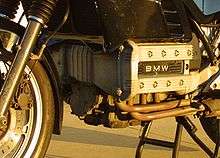
The first K-series production bike was the K100, which was introduced in the 1983. In 1988, BMW introduced the K1 which had the Bosch Motronic fuel injection system.
From 1985 to 1996, the K75 740 cc three-cylinder engine was produced.
In 1991, BMW increased the displacement of the K100 from 987 cc to 1,097 cc and the model designation became the K1100. The K1100LT was the first with the new engine displacement. In 1998 BMW increased the size again to 1,170 cc. This upgraded flat four engine appeared in the K1200RS. This engine continued in production for the K1200LT range, with a power boosting update in 2004, until the end of the LT production run.
The later K1200 engine is a 1,157 cc transverse inline-four, announced in 2003 and first seen in the 2005 K1200S. The new engine generates 123 kW (165 hp) and is tilted forwards 55 degrees. It is 43 cm (17 in) wide, giving the bikes a very low center of mass without reducing maximum lean angles.[36]
In October 2008, BMW announced the new K1300GT, K1300S and K1300R models, all of which feature a larger capacity 1293 cc engine producing up to 175 hp (130 kW). The new engine produces maximum power output 1,000 RPM lower than the previous engine, producing more torque due in part from a butterfly flap fitted in the exhaust.
In 2011, BMW launched the K1600 range—the K1600GT and K1600GTL—featuring a new 1,649 cc (100.6 cu in) straight-six engine, which is mounted transversely across the chassis.[37] The engine is angled forward by 50°.[38] The engine was originally used on the Concept 6, a concept bike that was shown at the 2009 EICMA Milan Motor Show.[39] BMW claims that the engine at 560 mm (22 in) wide, just 67 mm (2.6 in) wider than the K1300 engine,[38] is the narrowest six-cylinder engine ever produced. Cylinder bore is 72.0 mm (2.83 in) and the distance between cylinder centres 77 mm (3.0 in).[38] The camshaft is hollow, with cam lobes pressed on, which saves around 2 lb (0.91 kg).[40] The engine has electronic throttle control and multiple drive modes which can be set according to road conditions.
Model designation
BMW uses a three-segment nomenclature for motorcycles. The first segment indicates the engine type, the second indicates the approximate engine displacement in cubic centimeters (with one notable exception: the F 650 GS, which has an engine displacement of 798cc[41]), while the third indicates the class of motorcycle (e.g., sport, sport touring, dual-sport, etc.). The three segments are separated by blanks.[42][43][44]
A similar 3-segment nomenclature is used for BMW automobiles. However, there is significantly less consistency across the range with respect to the second segment (engine displacement/100).
Engine type:
- R – air-cooled, horizontally opposed ("boxer") 2-cylinder, oil-cooled 1994-2013, water-cooled after 2014
- K – water-cooled, inline 3-, 4- or 6-cylinder
- F – water-cooled, vertical 1-cylinder (through 2006), vertical 2-cylinder (after 2006)
- G – water-cooled, vertical 1-cylinder
- S – water-cooled, inline 4-cylinder superbike
Engine displacement in cc:
- Current models: 1600, 1300, 1200, 1000, 900, 800, 650 and 450. Previous models included 850, 1100, and 1150.
- Older model BMWs divide the approximate engine displacement by ten for the model number. For example, K75 ≈ 750 cc.
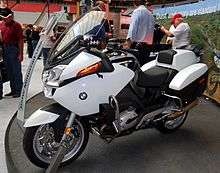
Styling suffix designations:
- C – Cruiser
- CS – Classic Sport
- G/S – Gelände/Strasse Off-road/Street
- GS – Gelände Sport Off-road Sport (Enduro)
- GT – Gran Turismo or Grand Touring
- LS – Luxury Sport
- LT – Luxus Tourer (Luxury Tourer)
- R – Road or Roadster, typically naked
- RR – Superbike/Racing
- RS – Originally stood for Rennsport, but since 1976 has stood for Reisesport[45]
- RT – Reise Tourer (Travel Tourer)
- S – Sport
- ST – Strasse (Street) or Sport Tourer
- T – Touring
Additionally, a bike may have the following modifiers in its name:
- A – ABS
- L – luxury
- P – police
- C – custom
- PD – Paris Dakar
Examples: K 1200 S, R 1200 RT, F 650 GS, R 1150 RSL, K 1200 LT, K 1200 LT-C, R 1200 RT-P, R 1200 RSA, S 1000 RR.
Prior to the introduction of the K 100 series and the R 1100 series motorcycles, the letter prefix was always the same, and the numbers were either based on displacement, as mentioned above, or were just model numbers.
Technologies
Rear suspension
Single-sided rear suspension
The first BMW monolever suspensions appeared in 1980 on the then-new R80G/S range. It had a single universal joint immediately behind the engine/gear-box unit. This system was later included on updated versions of the K & R Series.
Paralever
Paralever is a further advance in BMW's single-sided rear suspension technology (photo right). It decouples torque reaction as the suspension compresses and extends, avoiding the tendency to squat under braking and reducing tyre chatter on the road surface. It was introduced in 1988 R 80 GS and R 100 GS motorcycles.

In 2005, along with the introduction of the "hexhead", BMW inverted the Paralever and moved the torque arm from the bottom to the top of the drive shaft housing (photo right). This reduces underhang of components and tends to increase ground clearance in right lean.
The term "Paralever" is a portmanteau word from "Parallelogram" and "Lever". The "lever is the swinging arm; and the "parallelogram" is the shape between the four elements of the rear suspension (rear drive, drive shaft, transmission, and lower or upper brace). Other motorcycle manufacturers have patented similar designs, including Arturo Magni for MV Agusta and Moto Guzzi's Compact Reactive Shaft Drive.
Front suspension
Telescopic fork
In 1935, BMW fitted the first mass-produced hydraulically damped telescopic fork to its R12 and R17 motorcycles. BMW still uses telescopic forks today on its F-series, G-series, HP, and S1000RR motorcycles.
The R-series, which had used only the Telelever and the Duolever front suspensions for several years, has partly returned to telescopic forks in the 2015 model year with the introduction of the R 1200 R and R 1200 RS.[46]
Earles fork
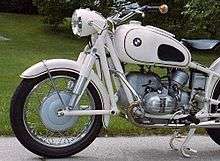
Englishman Ernest Earles designed a unique triangulated fork that, unlike telescopic forks, resists the side-forces introduced by sidecars.[47][48][49] BMW fitted the Earles fork to all its models for 14 years from 1955. In the event, this was the year that use of sidecars peaked and quickly fell off in most European markets (e.g. the UK) but the Earles fork system was well liked by solo riders too. It causes the front end of the motorcycle to rise under braking — the reverse of the action of a telescopic fork. The mechanical strength of this design sometimes proved to be a weakness to the rest of the motorcycle, since it transfers impact pressure to the frame where damage is more difficult and expensive to correct.
Telelever fork

Developed by Saxon-Motodd in Britain in the early 1980s, the Telelever fork aims to improve handling stability during cornering and braking. The Telelever uses conventional telescopic forks, but the stanchions contain only lubricating oil. Springing and damping functions are dealt with by a monoshock attached to a "Telelever" wishbone. The wishbone pivots on the front of the engine block, and the wishbone's forward end is attached via a rose-joint to a brace connecting the fork sliders. As there is no lower triple clamp, the fork sliders are longer and lighter than on a conventional telescopic fork, and the greater slider/tube overlap reduces both torsional flex and unsprung weight.
The Telelever system's main benefit is that it separates the steering function from the braking and suspension functions Braking forces are taken back via the wishbone, thereby eliminating brake dive. During braking, the trail and castor angle (rake) increases instead of decreasing as with traditional telescopic forks.Some riders used to conventional forks reported that the Telelever can initially lack "feel", and that the absence of dive is initially disconcerting;[50] but the R1100S BoxerCup Replika (a model with its own race series) shows that the Telelever fork provides responsive and predictable handling.[34][51]
The term "Telelever" is a portmanteau word from "Telescopic fork" and "Lever"; the "lever" being the wishbone arm.
Duolever

In 2004, BMW announced the K1200S, incorporating a new front suspension based upon a design by Norman Hossack.[52] BMW recognised this fact but paid Hossack no royalties.[53] BMW named its new front suspension the Duolever. As of 2009, the Duolever is on the K1300S, K1300R and K1300GT.
The official BMW Motorrad explanation of the duolever includes this:[54]
The advantage of this front wheel suspension on the motorcycle market at present is its torsional rigidity. The BMW Motorrad Duolever front wheel suspension is not influenced by negative forces in the same manner as a conventional telefork whose fixed and take-off tubes twist laterally as well as longitudinally during jounce/rebound and steering. Its two trailing links absorb the forces resulting from the jounce/rebound and keep the wheel carrier stable. Thus, any torsioning is excluded and the front wheel suspension is very precise. The steering commands of the rider are converted directly and the feedback from the front wheel is transparent in all driving conditions.
A kinematical anti-dive effect is additionally achieved, just as for the Telelever, due to the arrangement of the trailing link bearings. While a conventional telefork during strong braking manoeuvres jounces heavily or locks, the Duolever still has sufficient spring travel remaining in this situation and therefore the rider can still brake into the corner extremely late yet directionally stable.
See also
References
Citations
- 1 2 Norbye, Jan P., BMW - Bavaria's Driving Machines, pp. 14–17
- 1 2 Faloon, Ian (Feb 15, 2009). The BMW Boxer Twins Bible: All Air-Cooled Models 1970–1996 (Except R45, R65, G/S & GS). Veloce Publishing. pp. 6–7. ISBN 978-1-84584-1-683.
BFW decided to produce motorcycles, and its first effort was the Flink of 1920 with a 143cc Hanfland two-stroke engine.
- ↑ BM Bikes BMW R32 specifications
- ↑ Tragatsch, Erwin (1992-07-30) [1977]. Tragatsch, Erwin, ed. Illustrated Encyclopedia of Motorcycles (Second ed.). Book Sales. p. 89. ISBN 0-8900-9868-9. Retrieved 2013-06-02.
In 1925, the first BMW single was built, this was the R39... All BMWs built to 1929—except the R39 which was dropped in 1927—...
- 1 2 Wilson, Hugo (1995). "The A-Z of Motorcycles". The Encyclopedia of the Motorcycle. Dorling Kindersley. p. 28. ISBN 0-7513-0206-6.
- ↑ Gantriis, Peter; Von Wartenberg, Henry (2008). The Art of BMW: 85 Years of Motorcycling Excellence. MotorBooks International. p. 58. ISBN 978-0-76033-315-0.
- ↑ Gantriis, Peter, The Art of BMW: 90 Years of Motorcycling Excellence, p.58
- ↑ Holmstrom, Darwin, Nelson, Brian J., BMW Motorcycles, pp. 33-34
- ↑ Holmstrom & Nelson, pp. 34-36
- ↑ "Motorcycle Hall of Fame Museum: 1942 Harley-Davidson XA". Motorcyclemuseum.org. Retrieved 2011-02-25.
- ↑ Norbye, p. 76
- ↑ Gantriis, Peter, The Art of BMW: 90 Years of Motorcycling Excellence, p.98
- ↑ EMW roundel
- ↑ Greg Williams (May–June 2011). "The BMW /2 Series: Bavaria's Best?". Motorcycle Classics. Retrieved 2011-05-20.
- 1 2 3 4 5 Walker, Mick (2005-09-01). "1: Background". How To Restore Your BMW Twin: 1955-1985. Motorbooks Workshop (2nd ed.). pp. 18–20. ISBN 978-0-7603-2262-8. Retrieved 2013-11-06.
- 1 2 3 4 Norbye, p. 126
- ↑ Falloon, Original BMW Air-Cooled Boxer Twins 1950–1996, p. 21
- ↑ Gantriis, Peter, The Art of BMW: 90 Years of Motorcycling Excellence, p.120
- ↑ Holmstrom & Nelson, p. 83
- 1 2 3 Walker, Mick, How To Restore Your BMW Twin: 1955-1985, pp. 20-22
- ↑ BM Bikes BMW R100RS Specifications
- ↑ Sport Rider BMW K1200S specifications
- ↑ K1200R Sport
- ↑ "BMW Motorrad unveils new K-Series models - K Series celebrates 25th anniversary with 3 new models!". BMW Motorrad UK. 7 October 2008. Retrieved 2008-10-22.
- 1 2 Omorogbe, Jane (3 April 2008). "Ridden: BMW F800GS and F650GS". MSN. Retrieved 11 November 2009.
- 1 2 3 Brissette, Pete (20 April 2007). "2007 BMW G 650 X Series". Motorcycle.com. Archived from the original on 25 July 2014. Retrieved 16 October 2014.
- ↑
- ↑ Scoop BMW press release
- ↑ Carroll, Michael (2008-04-16). "BMW officially unveils World Superbike contender". Motorcycle News. Retrieved 2008-04-17.
- ↑ "BMW buys Husqvarna". Motorcycle News. 20 July 2007. Retrieved 2007-08-27.
- ↑ "BMW Motorrad acquires Husqvarna Motorcycles". American Motorcyclist Association. 20 July 2007. Retrieved 2007-08-27.
- ↑ "Is KTM the real owner of Husqvarna ?".
- ↑ http://classic-motorbikes.net/wp/bmw-r90s/
- 1 2 "Quick Spin: BMW R1100S BoxerCup Replika". What Bike: 39. Summer 2004.
- ↑ Ker, Rod (May 2005). "BMW singles". Classic Bike Guide. Morton Way, Horncastle, UK: Mortons Media Group. Archived from the original on 2013-05-02. Retrieved 2013-05-23. External link in
|work=(help) - ↑ BMW BMW technology site
- ↑ Madson, Bart (2 July 2010). "2011 BMW K1600GT First Look". Motorcycle USA. Retrieved 22 July 2010.
- 1 2 3 Hull, Matt. "BMW K1600GT & K1600GT-L". RiDE Magazine (September 2010): 123. ISSN 1360-3507.
- ↑ Madson, Bart (10 November 2009). "BMW Inline Six Motorcycle Concept". Motorcycle USA. Retrieved 22 July 2010.
- ↑ Ash, Kevin (25 August 2010). "Six appeal for BMW tourers". The Daily Telegraph.
- ↑
- ↑ BMW Motorrad Deutschland
- ↑ BMW Motorcycles: Bikes: F 650 GS
- ↑ BMW Motorrad International
- ↑ BMW Motorrad (6 October 2008). "BMW Product Name History". Motorcycle.com. Retrieved 19 November 2012.
- ↑ Wilson, Byron (September 30, 2014). "2015 BMW R1200R First Look". MotorcycleUSA.com. Archived from the original on 2014-11-11. Retrieved 2014-11-11.
- ↑ Falloon, Original BMW Air-Cooled Boxer Twins 1950–1996, pp 13–14
- ↑ Holmstrom & Nelson, p. 64
- ↑ GB patent 693646, Earles, Ernest, "Motor cycle front wheel forks", published 1953-07-01
- ↑ "Sportsbikes reviews: BMW R1100S (1998 - 2005)". Visordown. 14 September 2010. Archived from the original on 26 December 2014.
- ↑ "BMW R1100S". What Bike?: 41. Summer 2004.
- ↑ "BMW K1200S". Hossack Design. Retrieved 22 March 2010.
- ↑ "What is our fork technology?", broughsuperiormotorcycles.com
- ↑ "Duolever". BMW Motorrad. Archived from the original on 14 October 2007. Retrieved 22 March 2010.
Sources
- Falloon, Ian (2003). Original BMW Air-Cooled Boxer Twins 1950–1996. MotorBooks/MBI Publishing Company. p. 13. ISBN 978-0-7603-1424-1.
- Gantriis, Peter (2013-04-15) [2008]. "1937–1969". The Art of BMW: 90 Years of Motorcycle Excellence (revised ed.). Minneapolis MN USA: Motorbooks. ISBN 978-0-7603-4412-5. Retrieved 2013-05-02.
- Holmstrom, Darwin; Nelson, Brian J. (2002). BMW Motorcycles. St. Paul, MN, USA: MotorBooks/MBI Publishing Company. ISBN 0-7603-1098-X. Retrieved 2013-06-02.
- Norbye, Jan P. (1984). BMW - Bavaria's Driving Machines. Skokie, IL, USA: Publications International. ISBN 0-517-42464-9. LCCN 84060309.
Further reading
- Ash, Kevin (May 2006). BMW Motorcycles: The Evolution of Excellence. Whitehorse Press. ISBN 978-1-884313-57-8.
- Falloon, Ian (November 2003). The BMW story: production and racing motorcycles from 1923 to the present day. Sparkford, England: Haynes Publishing. ISBN 978-1-85960-854-8.
External links
| Wikimedia Commons has media related to BMW motorcycles. |
- BMW Motorrad worldwide homepage
- BMW motorcycles at DMOZ
